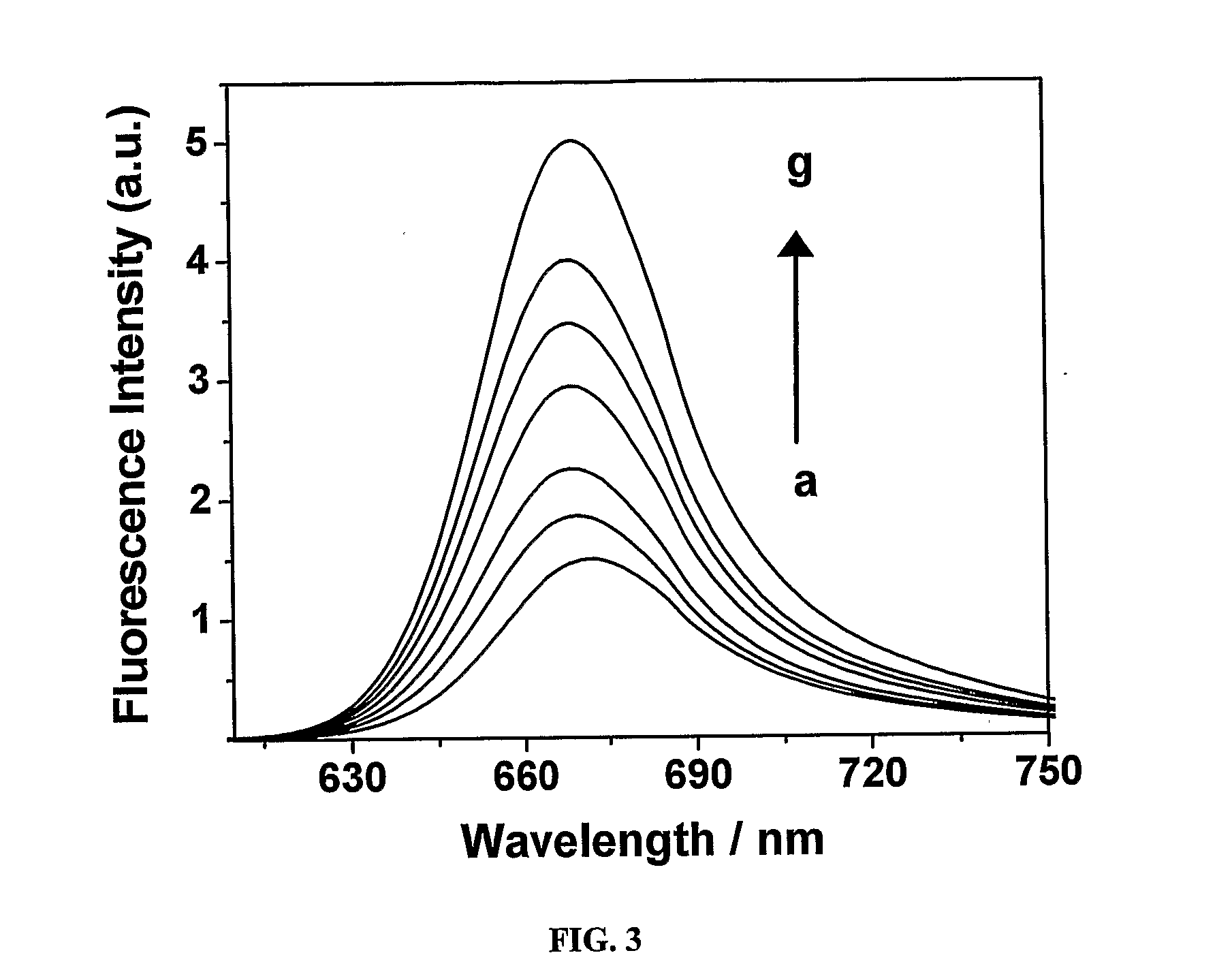Amphiphilic squaraine dyes, process for preparation thereof and use thereof
a technology of amphiphilic squaraine and dye, which is applied in the field can solve the problems of limiting the use of amphiphilic squaraine dye for the detection of tumors and reducing the potential for side effects
- Summary
- Abstract
- Description
- Claims
- Application Information
AI Technical Summary
Problems solved by technology
Method used
Image
Examples
example 1
[0036]Preparation of the squaraine dye of general formula 1, wherein R1=—(CH2—CH2—O)n—CH3, n=4 and R2=—CH3. A solution of N-methyl-N-(3,6,9,12-tetraoxamideca)aniline (400 mg, 1.35 mmol) and squaric acid (77 mg, 0.67 mmol) in a mixture of n-butanol and benzene (1:3) was refluxed by azeotropic distillation of water for 18 h. The solvent was distilled off under reduced pressure and the residue obtained was chromatographed over silica gel. Elution of the column with a mixture of methanol and chloroform (1:49) gave 110 mg (15%) of the squaraine dye of the general formula 1, wherein, R1=—(CH2—CH2—O), —CH3, n=4 and R2=—CH3, mp 100-102° C.; 1H NMR (300 MHz, CDCl3, 30° C., TMS): δ=3.21 (s, 6H, —NCH3), 3.37 (s, 6H, —OCH3), 3.72-3.52 (m, 32H, —OCH2), 6.81 (d, 4H, J=8.96, Ar—H), 8.39 (d, 4H, J=8.95 Hz, Ar—H); 13C NMR (75 MHz, CDCl3, 30° C., TMS): δ=39.68, 52.29, 58.97, 68.53, 70.42, 70.52, 70.56, 70.81, 71.83, 112.43, 119.90, 133.17, 154.41, 183.32, 188.58; IR (Neat): νmax 2877, 1610, 1584, 114...
example 2
[0037]Preparation of the squaraine dye of the general formula 2, wherein R1, R2=—(CH2—CH2—O)n—CH3, n=4. A solution of bis-(N,N-(3,6,9,12-tetraoxamideca)aniline (350 mg, 0.74 mmol) and squaric acid (42 mg, 0.37 mmol) in a mixture of n-butanol and benzene (1:3) was refluxed by azeotropic distillation of water for 18 h. The solvent was distilled off under reduced pressure and the residue obtained was chromatographed over silica gel. Elution of the column with a mixture (1:99) of methanol and chloroform gave 40 mg (5%) of the squaraine dye of the general formula 2, wherein R1, R2=—(CH2—CH2—O)n—CH3, n=4, mp 78-80° C.; 1H NMR (300 MHz, CDCl3, 30° C., TMS): δ=3.37 (s, 12H, —OCH3), 3.77-3.55 (m, 64H, —OCH2), 6.84 (d, 4H, J=8.96, Ar—H), 8.37 (d, 4H, J=8.95 Hz, Ar—H); 13C NMR (75 MHz, CDCl3, 30° C., TMS): δ=50.73, 58.91, 68.31, 70.38, 70.49, 70.53, 71.80, 111.54, 115.85, 129.15, 147.60, 183.32, 188.58; IR (Neat): νmax 2918, 2867, 1610, 1584, 1114 cm−1; Elemental analysis calcd (%) for C52H84N...
example 3
[0038]Preparation of squaraine dye of the general formula 3, wherein R1=—(CH2)n—CO2X, n=3, X=H, and R2=—CH3. N-methyl-N-(carboxypropyl) aniline (319 mg, 1.74 mmol) and squaric acid (100 mg, 0.87 mmol) were refluxed in a mixture of n-butanol and benzene (1:3) by azeotropic distillation of water for 24 h. The solvent was distilled off under reduced pressure to obtain a residue which was chromatographed over silica gel. Elution of the column with a mixture (1:9) of methanol and chloroform gave 100 mg (13%) of the squaraine dye of the general formula 3, wherein R1=—(CH2), —CO2X, n=3, X=H, and R2=—CH3, mp 238-240° C. (d); 1H NMR (300 MHz, [D6]DMSO, 30° C., TMS): δ=1.91 (p, 4H, —CH2), 2.40 (t, 4H, J=7.2 Hz, —CH2), 2.91 (s, 6H, —NCH3), 3.35 (t, 4H, J=7.3 Hz, —CH2), 6.99 (d, 4H, J=9.07 Hz, Ar—H), 8.05 (d, 4H, J=8.97 Hz, Ar—H); 13C NMR (75 MHz, [D6]DMSO, 30° C., TMS): δ=21.82, 31.41, 38.46, 52.03, 112.64, 116.73, 129.17, 149.13, 179.23; IR (KBr): νmax 3420, 2924, 1729, 1590, 1439, 1130 cm−1;...
PUM
| Property | Measurement | Unit |
|---|---|---|
| Temperature | aaaaa | aaaaa |
| Time | aaaaa | aaaaa |
| Fraction | aaaaa | aaaaa |
Abstract
Description
Claims
Application Information
 Login to View More
Login to View More - R&D
- Intellectual Property
- Life Sciences
- Materials
- Tech Scout
- Unparalleled Data Quality
- Higher Quality Content
- 60% Fewer Hallucinations
Browse by: Latest US Patents, China's latest patents, Technical Efficacy Thesaurus, Application Domain, Technology Topic, Popular Technical Reports.
© 2025 PatSnap. All rights reserved.Legal|Privacy policy|Modern Slavery Act Transparency Statement|Sitemap|About US| Contact US: help@patsnap.com



